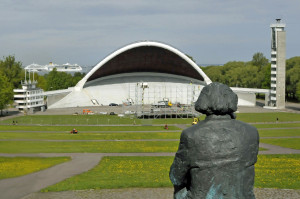Beginning in the thirteenth century, the region of Estonia, lying north of Latvia and west of Russia, was ruled by Denmark, Poland, Sweden and finally, Russia. Residents, most of them peasants, considered themselves “country people,” bound to whichever foreign power controlled them. In 1857, Johann Voldemar Jannsen, publisher of the first Estonian language newspaper, began calling his readers “Estonians.” He and his daughter then organized a “song fest,” held in June 1869 in Tartu. About 12,000 people listened for two days as an 822-member choir sang folk songs, encouraging Estonians to see themselves as a separate people. After four more festivals, the event moved to Tallinn, Estonia’s largest city. The sense of national identity and cohesion created by the song fests led to Estonia’s declaration of independence from Russia in 1918.
In 1940, the Soviet Union took control of Estonia, along with the other Baltic states of Latvia and Lithuania. The Tallinn song fests continued, with Russian songs added. An enormous stage, holding 15,000 singers, was built on a hillside above the harbor. In September 1988, 300,000 Estonians, nearly one-fourth of the country’s population, assembled before and on the Tallinn stage. They sang patriotic songs, raised the banned Estonian flag and demanded independence, leading to sustained protests in what became known as the “Singing Revolution.” On August 20, 1991, Estonia, called the “singing nation,” successfully declared its independence as the Republic of Estonia.
Every five years, more than 100,000 people come together in Tallinn, where they listen to choirs including 30,000 performers while a flame atop a 42-meter tower celebrates the country’s freedom. Because of its importance in forming a nation, the Estonia Song Festival is on the UNESCO Intangible Cultural Heritage list.
